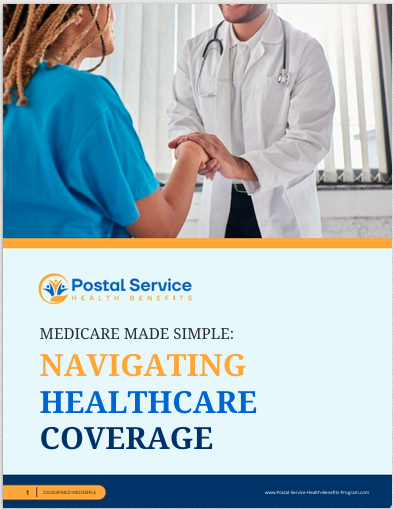Key Takeaways
-
The new $2,000 Medicare Part D drug cap eliminates financial uncertainty for prescription costs, helping Postal Service Health Benefits (PSHB) participants better plan their healthcare budgets.
-
This change simplifies out-of-pocket expenses, offering peace of mind and promoting better adherence to prescribed medications.
Breaking Down the $2,000 Medicare Part D Drug Cap
Starting in 2025, Medicare Part D introduces a game-changing policy: a $2,000 annual out-of-pocket cap on prescription drug costs. For Postal Service Health Benefits (PSHB) participants, this cap is a significant step forward. It ensures that once you hit the $2,000 limit, you won’t have to pay additional out-of-pocket costs for your covered medications for the rest of the year.
This update replaces the old system—one that included the infamous “donut hole” or coverage gap—and simplifies how your prescription drug costs are handled. If you’ve struggled to predict or budget for medication expenses, this is a huge relief. Let’s dive into why this change matters and how it benefits you.
Financial Stability for Your Budget
Predictable Costs, Less Guesswork
Previously, planning for annual healthcare expenses was challenging. You might’ve faced fluctuating costs depending on your prescriptions, plan tiers, or whether you hit the catastrophic phase of Part D. Now, with the $2,000 cap in place, you’ll know your maximum financial commitment for prescription drugs every year. This predictability allows for better financial planning—a crucial benefit when juggling other expenses.
Shielding Against High Drug Costs
Medications for chronic or serious conditions can be extremely expensive. Under the old system, high costs often pushed people into the catastrophic coverage phase, which still required partial out-of-pocket spending. With the $2,000 cap, you’re protected from runaway costs, giving you greater peace of mind.
Why This Matters for PSHB Participants
Simplifying Medicare Coordination
As a PSHB enrollee, your healthcare coverage often works in tandem with Medicare once you become eligible. This new cap enhances that coordination. Many PSHB plans already offer integrated prescription drug coverage, which means this Medicare improvement directly reduces your financial burden.
Additionally, this change supports smoother transitions for newly eligible retirees. Whether you’re navigating Medicare for the first time or balancing it with your existing PSHB benefits, the $2,000 limit simplifies your out-of-pocket calculations.
Encouraging Medication Adherence
High costs have historically been a barrier to medication adherence. Some people may skip doses or avoid filling prescriptions entirely to save money, putting their health at risk. With an annual spending cap, you’re more likely to stick to your prescribed treatments without worrying about unexpected bills. In the long term, this leads to better health outcomes and fewer complications.
How the $2,000 Cap Works in Practice
Phases of Part D Coverage Simplified
Medicare Part D’s new structure is easier to understand. Here’s a quick breakdown of what happens in 2025:
-
Deductible Phase: You’ll pay for prescriptions until you meet your plan’s deductible (up to $590 in 2025).
-
Initial Coverage Phase: After meeting the deductible, you pay a percentage of drug costs, with your plan covering the rest.
-
Catastrophic Coverage Phase Eliminated: Instead of entering a catastrophic phase after hitting a coverage gap, the $2,000 cap takes over. Once your out-of-pocket costs reach this limit, your plan covers 100% of your prescription drug costs for the rest of the year.
Timing and Payments
The cap resets annually on January 1, giving you a fresh start each year. To make payments more manageable, Medicare also introduces a prescription payment plan that lets you spread costs over the calendar year. This flexibility can further ease the strain on your monthly budget.
Maximizing the Benefits of the $2,000 Cap
Review Your Current Plan
PSHB participants should take time to review their plan’s prescription drug coverage during the Open Season (November 11 to December 13, 2025). Ensure your plan aligns with your medication needs and integrates seamlessly with Medicare Part D. Comparing out-of-pocket limits, copayments, and drug formularies can help you make the most of this new benefit.
Keep Track of Your Spending
Even with the $2,000 cap, keeping track of your prescription drug spending is essential. Use tools like plan-provided cost trackers or Medicare’s online resources to monitor how close you are to reaching the limit. Staying organized will help you avoid surprises and better plan for other healthcare costs.
Addressing Common Questions About the $2,000 Cap
What Happens if My Costs Reach the Cap Early in the Year?
Once you hit the $2,000 cap, you won’t owe any additional out-of-pocket costs for covered prescriptions. Your plan will cover the remaining costs for the rest of the calendar year. This can be particularly helpful if you require high-cost medications.
Does the Cap Apply to All Drugs?
The $2,000 limit applies to medications covered under your plan’s formulary. It’s a good idea to check whether your prescriptions are included to avoid unexpected costs. If you’re unsure, contact your plan’s customer service or review the formulary online.
How Does the Payment Plan Work?
If the $2,000 cap feels like a lot to pay at once, the new prescription payment plan lets you spread your out-of-pocket costs across monthly installments. This option can help manage expenses without disrupting your budget.
The Bigger Picture: Why This Matters Now
This change isn’t just a win for individuals; it reflects broader efforts to make healthcare more accessible and affordable. Rising prescription drug costs have long been a source of stress for Americans, particularly those on fixed incomes like retirees. By capping out-of-pocket expenses, Medicare Part D is setting a new standard for cost control.
For PSHB participants, who already benefit from a strong network of healthcare options, this added layer of financial protection makes your overall coverage even more robust. Whether you’re managing a chronic condition or just preparing for future healthcare needs, this update ensures that your costs remain predictable and manageable.
What You Should Do Next
As 2025 progresses, stay informed about how these changes affect your PSHB and Medicare coverage. Take advantage of resources provided by your plan and Medicare to understand how the new cap integrates with your benefits. Most importantly, don’t hesitate to reach out to your plan’s representatives if you have questions.
Remember, Open Season is the perfect time to reassess your healthcare needs and make changes if necessary. By taking proactive steps, you’ll be better prepared to maximize the benefits of this significant Medicare update.
Simplify Your Healthcare Budget with the New Drug Cap
The $2,000 Medicare Part D drug cap marks a pivotal moment in making prescription drug costs more manageable for PSHB participants. By offering financial stability, encouraging medication adherence, and simplifying cost structures, this change paves the way for better health and peace of mind. As you navigate your healthcare options, let this new policy work to your advantage.






